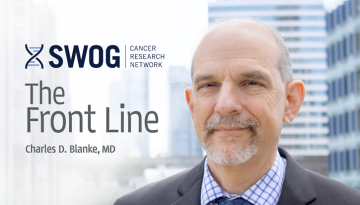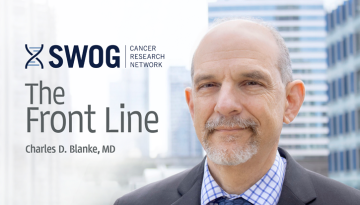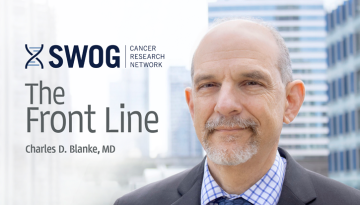Allocating Our Protocol Development Resources
In determining how many clinical trials SWOG can have under development at any given time, the group has long applied a rule of thumb allowing three studies per NCTN research committee. But the rules have been somewhat fuzzier for the NCORP side, and we had no mechanism allowing the research support committees such as the Adolescent and Young Adult and the Immunotherapeutics Committees to conduct primary studies.
Wanting to figure out how to most efficiently allocate protocol development resources across research committees while also providing some resources to research support committees, last December I commissioned a protocol resourcing task force led by SWOG Deputy Chair Dr. Primo “Lucky” Lara.
I asked the task force to develop mechanisms for visualizing and allocating statistical and operational protocol development resources fairly and transparently across SWOG’s research and research support committees. The mechanisms should allow our chairs to better prioritize and strategize.
The task force met virtually several times to agree to a set of recommendations, and its members – with the help of others – spent many additional hours categorizing and further developing the resources that would allow those recommendations to be enacted.
The group delivered four recommendations to recent meetings of SWOG’s committee chairs and executive advisory committee:
- Deploy an interactive protocol resource dashboard that displays protocol development staff capacity, both available and encumbered, across SWOG committees.
- Formulate a protocol complexity metric that can be measured at the capsule triage stage.
- Establish a fixed-slot model to allocate protocol development resources to research and research support committees, with flexibility to allow clinical trials to be added based on available resources and concept priority.
- Use the SWOG triage mechanism to govern the allocation of these flexible slots.
Protocol resource dashboard. The task force outlined the needed dashboard capabilities, and SWOG Chief of Administration Nathan Eriksen went and built it. Eriksen wowed the group’s executive officers and committee chairs last month with demos of this tool, which will soon be available to committee chairs, co-chairs, and vice chairs.
Our protocol development staff represent a critical and limited resource. The dashboard will help us deploy their expertise more prudently and equitably.
Protocol complexity metric. New capsules submitted to triage will now be rated as either “complex” or “not complex” as a relative indicator of how resource-intensive the protocol development process is anticipated to be. Our clinical trial project managers will assign these scores based on rubrics. The rubric for NCORP trials is still being developed; the rubric for NCTN trials includes measures of investigational new drug status, the number and types of trial correlatives, the complexity of the collaboration involved, whether the study will be used for FDA registration of a drug, and whether the study is disease specific. Committee chairs can use this metric as they’re deciding which concepts to put forward.
Fixed-slot model. The task force debated whether to use a dynamic allocation system in which all trial development slots are allocated from a single “pot” or a fixed-slot system in which each committee has a set number of slots to use. The group chose the latter model, with each research committee having three slots for clinical trials in development at any one time and with select research support committees having one slot each.
This does not mean each research committee can have only three trials open at a time. A “slot” represents an opening in the protocol development process. It extends from the moment of NCI approval of a concept to the date of trial activation.
Flex slot allocation. The proposed fixed-slot model is supplemented with a pre-defined number of “flex” slots, determined based on remaining protocol development resources (i.e., protocol coordinator hours). Rather than proposing a separate governance body for allocating these flex slots, the task force recommended the executive conference triage group should allocate them.
We recognize that these recommendations don’t resolve all challenges or account for all variables, but they should go a long way to ensuring a more equitable process for allocating our limited protocol development resources in the face of having almost too many good ideas. They remain a work in progress, and the task force continues to refine and extend them. I want to thank Lucky Lara and his co-workers for building something that will be a real game-changer. For our researchers, and for our patients.
We are now planning our fall group meeting (October 13-16) as a hybrid in-person/virtual event. Due to the circumstances created by COVID-19, vaccination is an expectation to attend group meeting.
Meeting details will be posted to the SWOG website in the coming weeks, but we wanted to get out word of the vaccination expectation as soon as possible.
Other Recent Stories



